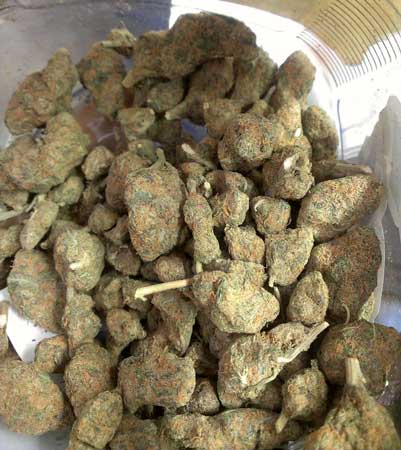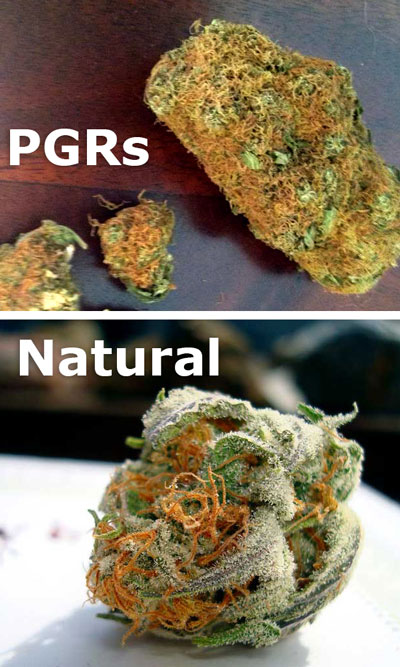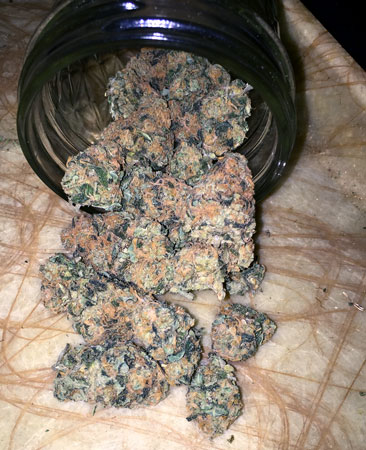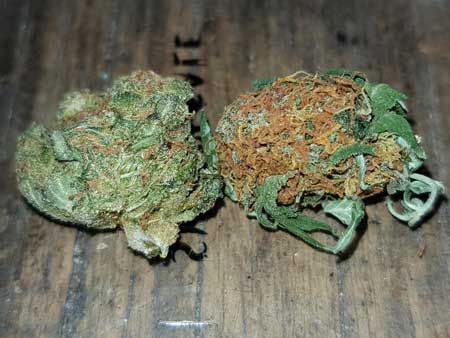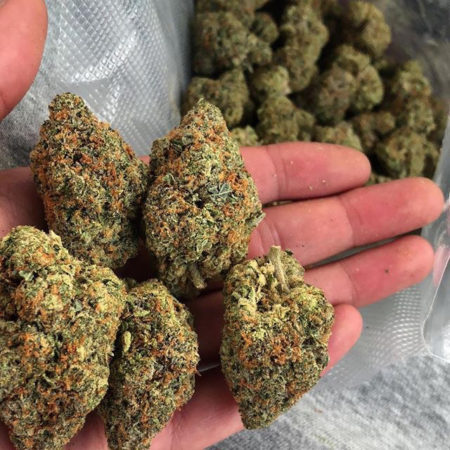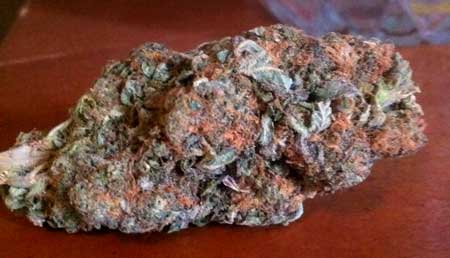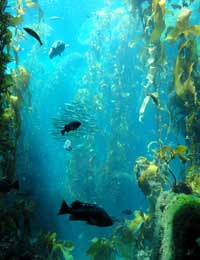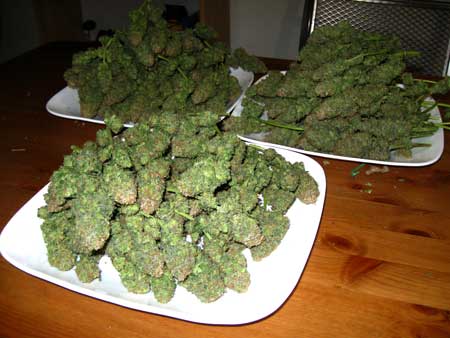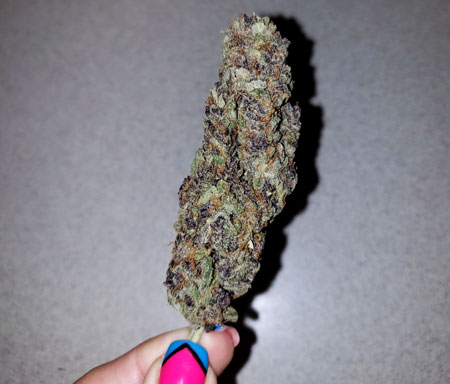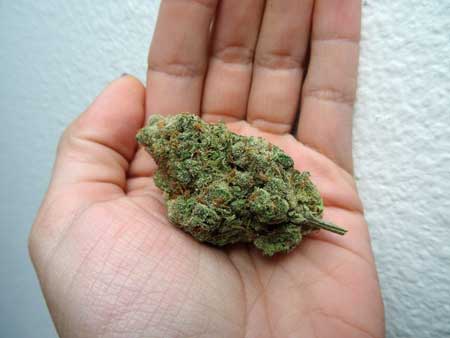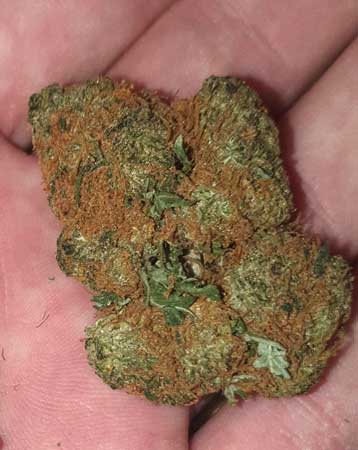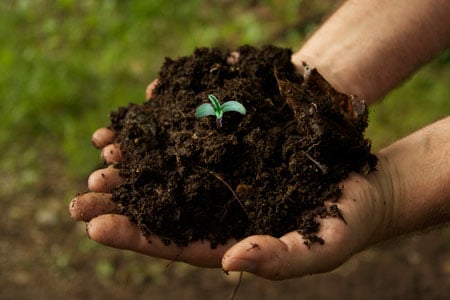by Nebula Haze
When you see ultra-dense cannabis buds with an odd orange or dull brown coloring, they may have been treated with a synthetic PGR in the flowering stage. No good!
What’s wrong with these beautiful dense “hardball” buds? They were grown with synthetic PGRs.
Here’s a comparison of PGR-treated buds vs. naturally grown buds. It’s normal for weed to have orange hairs, but PGR-buds are often completely engulfed by them.
PGR is short for “plant growth regulator”. PGRs act kind of like hormones and, and some plants naturally produce PGRs. However, synthetic (human-made) PGRs were developed in the early 1900s to promote dense flowers and keep plants unnaturally short and bushy.
Two popular human-made PGRs are Paclobutrazol (Paclo) and Daminozide (also known as Alar).
Synthetic PGRs are still commonly used for grass on lawns (to keep it short) and ornamental plants (for uniform, weighty flowers), but many common synthetic PGRs were banned in the USA during the 1980s for use on any crops meant for human consumption.
Why? Because these systemic compounds remain in the plant tissue (regardless of flushing) and once consumed, there is evidence they cause cancer, liver damage, and other harmful effects in mammals.
The odd orange coloring is a sign these buds were grown with synthetic PGRs, which are bad for you!
How can you tell if a bud was grown with synthetic PGRs?
- An over-abundance of orange hairs (orange hairs are natural, but PGR buds typically have far more than normal).
- Buds may be orange all the way through
- After being dried and cured the buds may take on a dull brown appearance like it’s been vaped or decarbed
- Less than normal trichome coverage (little “sparkle”)
- Buds are tighter and denser than usual for that strain
- Buds seem small for the weight
- Buds tend to have rounded smooth edges like each individual nug was vacuum-sealed or pressed (though they could just be vacuumed-sealed or pressed)
- Buds may feel “spongey” or squishy
- PGR buds often have a relatively low smell
- The more PGRs used during the growing process, the more stark the differences
Note: You may find naturally grown buds with some or all of these traits. This is a list of possible clues, but there is no way to prove (without testing) that buds contain PGRs. The fact that it can be difficult to tell is one of the reasons it’s great to grow your own!
What’s the inside like? Here’s an example of natural buds (left) vs. PGR buds (right) after they’ve been ground up. Notice how the PGR buds are orange all the way through. Picture by Toradorkat.
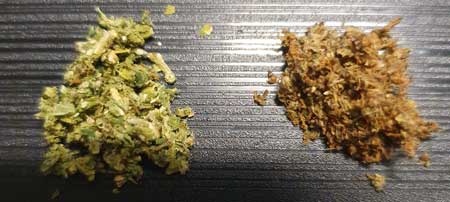
In 2011, it was discovered by the California Department of Food and Agriculture (CDFA) that several common plant supplements contained undisclosed levels of Paclo and Alar, including Bushmaster, Top Load, Gravity by Emerald Triangle, Phosphoload, and a popular supplement called Flower Master.
Over the next few years, these supplements and others were pulled off the shelves or reformulated to remove the PGRs. I remember the hubbub as several commercial producers were upset because these supplements made a huge difference to bud yield and density (just look at the pictures!). Doesn’t that mean we’re now safe from PGRs? Unfortunately, no. Companies are not required to list all ingredients on supplements, and there is evidence some companies still add PGRs.
Naturally dense buds are beautiful. Just watch out for extremely dense buds with rounded edges and unusual orange coloring, especially if you don’t know who grew it!
This strain normally produces completely purple buds but the hairs still came in bright orange.
What about PGRs naturally found in plants? Are those safe to give to weed?
The safety of natural PGRs isn’t well understood. Even though some PGRs come from natural sources, that doesn’t prove for sure that they are safe for humans when given to weed. On the other hand, you have kelp supplements (which have been used naturally for thousands of years) that are now classified at PGRs. Unfortunately, there’s no neat or easy answer.
That being said, I’ve yet to see any evidence that the natural PGRs commonly used for growing have harmful effects on humans. Contact us to share your experience with natural PGRs.
Kelp, alfalfa, and other organic sources contain natural PGRs. Unlike synthetic PGRs, I haven’t seen any evidence that natural PGRs are harmful to humans.
My buds are dense, does that mean they were grown with PGRs?
No.
Just because buds are dense does not mean they were grown with PGRs. If you don’t see the other symptoms listed on this page (orange coloring, spongey texture, low smell, etc.), then chances are the buds are fine.
Here are examples of naturally dense buds grown without any PGRs
Does my supplement contain PGRs?
Just a few years ago, many growers were unknowingly using plant supplements containing synthetic PGRs that weren’t listed on the label. Many of these products were removed from the shelves or reformulated, but some supplements still contain them.
Beware supplements by lesser-known companies that claim to make buds denser, especially if buds turn out like this!
How to ensure you aren’t giving your plants PGRs:
- Do your research before buying supplements from unfamiliar companies.
- Contact the nutrient company through their website and ask directly. I’ve been surprised by how responsive and helpful most nutrient companies are when you email them.
- Beware supplements that claim to keep plants short, halt vertical growth, or make buds more tight/dense. Especially if they’re vague about the ingredients.
- Or simply skip using supplements altogether. Base nutrients grow high-quality buds and rarely contain PGRs.
- Consider growing organically (for example, with super soil) or using 100% organic sources of nutrients.
If you grow organically, you don’t need to worry about synthetic PGRs

